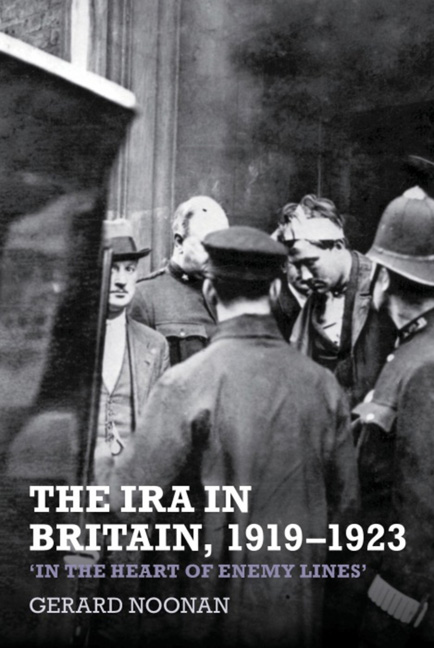Book contents
- Frontmatter
- Contents
- List of Illustrations
- List of Tables
- List of Graphs
- List of Abbreviations
- Acknowledgements
- Introduction
- Prologue
- 1 ‘On a Solid Footing’: Organizing Republicanism in Britain, January 1919–July 1921
- 2 Supplying an Army: Gunrunning in Britain, January 1919–July 1921
- 3 ‘We are doing what you are doing in Ireland’: IRA Operations in Britain, January 1919–July 1921
- 4 Truce, Treaty and Dissension, July 1921–June 1922
- 5 The Civil War, June 1922–May 1923
- 6 Combating the ‘Sinn Fein Movement’ in Britain: The Response of the Authorities, 1919–1923
- Epilogue and Conclusion
- Select Bibliography
- Index
Prologue
- Frontmatter
- Contents
- List of Illustrations
- List of Tables
- List of Graphs
- List of Abbreviations
- Acknowledgements
- Introduction
- Prologue
- 1 ‘On a Solid Footing’: Organizing Republicanism in Britain, January 1919–July 1921
- 2 Supplying an Army: Gunrunning in Britain, January 1919–July 1921
- 3 ‘We are doing what you are doing in Ireland’: IRA Operations in Britain, January 1919–July 1921
- 4 Truce, Treaty and Dissension, July 1921–June 1922
- 5 The Civil War, June 1922–May 1923
- 6 Combating the ‘Sinn Fein Movement’ in Britain: The Response of the Authorities, 1919–1923
- Epilogue and Conclusion
- Select Bibliography
- Index
Summary
I
Irishmen hae [i.e. have] now for the first time in over a hundred years the opportunity of arming and learning the use of arms, and the hot blood of our dead and gone warrior sires will surge so in their veins as they see things militant materialise that they must sooer [i.e. sooner] or later “fall in” in their places amongst the manhood of Erin, and that is now assuredly in the ranks of the Irish Volunteers.
So wrote the secretary of the nascent 1st Glasgow and West of Scotland Regiment of the Irish Volunteers in early March 1914. The outfit, also known as the Sarsfield Regiment, in honour of Patrick Sarsfield, an Irish military leader who fought in the Williamite Wars of 1689–91, initially numbered ten ‘skeleton companies’. By August, it had expanded to the districts of Stirlingshire, Lanarkshire, Renfrewshire and Ayrshire, and boasted an estimated membership of 2,590. The Volunteer organization also spread through England and Wales. The Rhondda Valley soon had over 1,000 members, Tyneside almost 700, Cardiff at least 560, Manchester a ‘very large number’, London at least 480 and Wigan 100. One of the founders of the Volunteers on Merseyside later claimed that the membership there quickly reached 1,200. Units also existed in Sheffield, Bolton, Glamorgan and Swansea Valley. ‘England and Scotland are both dotted with corps drilling and making ready,’ noted the Irish Volunteer newspaper, ‘and a few enthusiasts have spread the flame from coast to coast.’
The flame had been lit in Dublin in November 1913 when a group of nationalists, led by Eoin MacNeill, the founder of the Gaelic League, established the Volunteers. They were reacting to the Ulster Unionists who – in opposition to the British government's plan to grant a limited form of autonomy or ‘home rule’ to Ireland – had established a paramilitary outfit, the Ulster Volunteer Force, and threatened rebellion. Enraged by the Unionists’ success in forcing the government to contemplate the partitioning of Ireland into nationalist and unionist blocs, the nationalists in Dublin hoped that a paramilitary army of their own, the Irish Volunteers, would intimidate the government into honouring its pledge for all-Ireland home rule.
- Type
- Chapter
- Information
- The IRA in Britain, 1919–1923‘In the Heart of Enemy Lines’, pp. 7 - 32Publisher: Liverpool University PressPrint publication year: 2014



